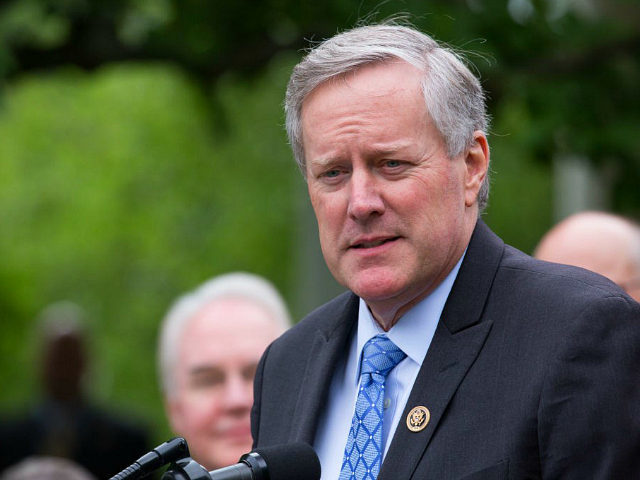
© Cheriss May/NurPhoto via Getty ImagesMark Meadows
A House Oversight Committee hearing discussed the impact of the unprecedented rate at which President Barack Obama passed regulations and President Donald Trump has begun to repeal them.
"According to the Federal Registry, agencies issued 3,280 rules last year.
This amounts for less than nine new rules per day, including weekends and federal holidays ," said Rep. Mark Meadows, R-North Carolina. "Now that's an improvement over the previous Administration where we saw ten and a half rules passed each day in 2016."
Amit Narang, regulatory policy advocate at the liberal Public Citizen, said Trump's stance against greater regulation threatens public safety.
"President Trump has justified his deregulatory agenda as a means to create economic growth. After one year, the evidence is clear that there has been no such economic growth," Narang said. "Both GDP and jobs figures show that there has been no greater economic growth under this Administration than there was under the last Administration."
Regulatory growth has slowed under Trump, but the hearing, titled, "
Shining Light on the Federal Regulatory Process," showed that another problem has remained:
Regulatory agencies have not followed the Congressional Review Act or the policies prescribed by the Office of Management and Budget.
The hearing focused on the inability or unwillingness of regulatory agencies to comply with rules about "guidance" - the process that they use to show Congress how they will implement new regulations.
The House Oversight Committee defined Regulatory guidance as "an agency's statement of policy or interpretation of a statute or regulation. These documents can have a significant effect on the public and can alter the behavior of regulated parties."
As regulatory agencies gained more power to create rules and regulations without the oversight of Congress, President Ronald Reagan signed Executive Order 12291, which required that the OMB review new regulations.

Paul Noe
Reagan's executive order "was quite broad in scope and applied to virtually all "rules" - including both regulations (legally binding legislative rules) and agency guidance (non-binding interpretive rules and policy statements)," said Paul R. Noe, vice president of public policy at the American Forest & Paper Association.
Years later, President Bill Clinton signed Executive Order 12866, which decreased the scope of regulatory review to rules with a "significant" economic impact.
As regulatory oversight faded, so did the guidance of regulatory agencies, according to Noe.
The problem became one of more than sheer number.
The federal government passed a lot of regulations,
but more importantly they stopped telling people how to comply with them.Clinton's executive order stopped the OMB from reviewing guidance documents, since they didn't have significant impact, so regulatory agencies stopped issuing them and submitting them to Congress.
"Although guidance documents may not properly carry the force of law, they are a key component of regulatory programs," Noe said. "As the scope and complexity of regulatory programs has grown, agencies increasingly have relied on guidance documents to provide direction to their staff and to the public."
The report that arose from the hearing came with three key findings.
First, regulatory agencies themselves don't have a full account of their guidance documents. When the House Oversight Committee requested guidance documents from the last 10 years for 46 federal agencies, they received more than 13,000 documents. Some of the agencies didn't comply with the committee's request, or they simply didn't have any guidance documents to provide.
Second, regulatory agencies don't know the legal definition of guidance, so they didn't know what documents to provide.
Third, regulatory agencies have not submitted the guidance documents to Congress that the Congressional Review Act required them to."Of the more than 13,000 guidance documents identified for the Committee,
only 189 were submitted to Congress and the Government Accountability Office (GAO) in accordance with the CRA," the report found.
The report provided solutions for regulatory agencies.
They need to submit guidance documents that the law requires them to.
"When there is a lack of clarity about whether a guidance document should be submitted to Congress and GAO under the CRA, agencies should seek guidance from GAO and Congress," the report said.
The non-issuance of regulatory guidelines becomes increasingly poor during the end of presidential terms.
Lame duck presidents, especially Clinton, Bush, and Obama, passed two to three times as many regulations during the last few months of their terms than any other part of their tenure. These lame-duck regulations are rarely submitted to Congress for oversight."Agencies reported to the Committee that they had submitted just 189 guidance documents to Congress and the GAO, as it is required by the CRA. That's a submission rate of less than 0.015 percent," Meadows said. "GAO will never be able to review the more than 12,800 guidance documents in our limited sample, let alone the entire universe of the agency guidance and there is some sort of disconnect between what the law says and what agencies do."
I think America should agree to take the constitution and the bill of rights, and scrap ALL of the laws and rules that were created after those two documents were written. We need a total reset and redo of all the laws and the government. It's all gotten to stupid to actually function, too bloated and corrupt.